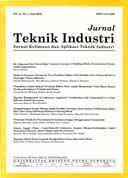Multi-Objective Optimization of Machining Parameters for Multi-Pass CNC Turning to Minimize Carbon Emissions, Energy, Noise and Cost
DOI:
https://doi.org/10.9744/jti.23.1.25-34Keywords:
sustainable manufacturing, multi-objective optimization, energy, cost, carbon emissions, noiseAbstract
Global warming is a huge environmental issue today. This is due to the high level of world carbon emissions. The manufacturing process accounts for 30% of the world's carbon emissions production. Sustainable manufacturing is necessary to implement to reduce carbon emission levels caused by the manufacturing process. There are three aspects of sustainable manufacturing, namely environmental aspects, economic aspects, and social aspects. These three aspects can be implemented in the machining process by optimizing machining parameters in multi-pass CNC turning. This research aims to optimize CNC turning machining parameters by considering energy consumption, carbon emissions, noise, and production cost. The model is solved using a Multi-objective Genetic Algorithm in Matlab 2016b then the transformation and weighting functions are carried out from the feasible value. Based on the optimization results, the total energy consumption value obtained is 2.50 MJ; total production cost is $ 2.19; total carbon emissions are 5.97 kgCO2, and noise is 236, 19 dB. The sensitivity analysis exhibits the machining parameters that affect the objective function: The cutting speed parameter and the feed rate parameter. This model can be used to improve the manufacturing process and support sustainable manufacturing.
Downloads
References
Zhang, L., Zhang, B., Bao, H., and Huang, H. Optimization of Cutting Parameter for Minimizing Environmental Impact: Considering Energy Efficiency, Noise Emission and Economic Dimen-sion. International Journal of Precision Engineering and Manufacturing, 19(4), 2018, pp. 613-624.
Zhao, Y., Ke, J., Ni, C.C., McNeil, M., Khanna, N.Z., Zhou, N., Fridley, D., and Li, Q. A Comparative Study of Energy Consumption and Efficiency of Japanese and Chinese Manufac-turing Industry, Energy Policy, 70, 2014, pp. 45-55.
Li, C., Tang, Y., Cui, L., and Li, P. A Quantitative Approach to Analyze Carbon Emissions of CNC Based Machining System, J Intell Manuf, 2013.
United Nations. Kyoto Protocol to the United Nations Framework Convention. On Climate Change, 1998, Kyoto.
Lu, T., Gupta, A., Jayal, D., Badurdeen, F., Feng, S. C., Dillon, O. W., and Jawahir, I. S. A Framework of Product and Process Metrics for Sustainable Manufacturing, Global Conference on Sustainable Manufacturing, Geithsburg, Springer, 2011, pp. 333-338.
Wang, Q., Liu, F., and Wang, X. Multi-Objective Optimization of Machining Parameters Consi-dering Energy Consumption. International Journal of Advance Manufactruing Technology, 2013, pp. 1133-1142.
Bagaber, S. A., and Yusoff, A. R. Energy and Cost Integration for Multi-Objective Optimisation In A Sustainable Turning Process. Measurement, 2019, pp. 795-810.
Lin, W., Yu, D.Y., Zhang, C., Liu, X., Zhang., S., Tian, Y., Liu, S., and Xie, Z. A Multi-Objective Teaching-Learning-Based-Optimizatio Algorithm to Scheduling in Turning Processes for Minimizing Makespan and Carbon Footprint. Journal of Cleaner Production, 2015, pp 1- 46.
Jiang, Z., Gao, D., Lu, Y., and Liu, Xianli. Optimization of Cutting Parameters for Trade-off Amog Carbon Emissions, Surface Roughness, and Processing Time. Chinese Journal of Mechanical Engineering, 32:94, 2019, pp 1-18.
Arif, M., Stroud, I. A., and Akten, O. A Model to Determine the Optimal Parameter for Sustainable-Energy Machining in Multi-Pass Turning Operation. Journal Engineering Manufacture, 228(6), 2013, pp. 866–877.
Chen, M. C., and Tsai, D. M. A Simulated Annealing Approach for Optimization of Multi-Pass Turning Operation, International Journal of Production Research, 34(10), 1996, pp. 2803-2825.
Cirtu, N. D., Dimitriu, R., D Hartley., and Golder A. A., Survey of the Noise Levels of Metal-cutting
Machine Tools, Proceedings of the Sixteenth International Machine Tool Design and
Research Conference, 1976, pp. 363-269.
Whitley, D. A Genetic Algoritm Tutorial. Statistics and Computing, 1994, pp. 65-85.
Mawaddah, N. K., and Mahmudy, W. F.Optimasi Penjadwalan Ujian Menggunakan Algoritma Genetika, Kursor, 2016, pp. 1-8.
Marler, R.T., Arora, J.S. Survey of Multi-Objective Optimization Methods for Engineering. Structural and Multidisciplinary Optimization, 26, 2004, pp. 369-395.
Marler, R.T., Arora, J.S. The Weighted Sum Method for Multi-Objective Optimization: New Insights, Structural and Multidisciplinary Opti-mi¬zation, 41, 2010, pp. 853-862.
Addona, D. A., and Teti, R. Genetic Algorithm Based Optimization of Cutting Parameters in Turning Processes. Procedia CRIP (7), 2013, pp. 323-328.
Tian, C., Zhou, G., Zhang, J., and Zhang, C. Optimizaton of Cutting Parameters Considering Tool Wear Conditions in Low-Carbon Manufac-turing Environment. Journal of Cleaner Production, 2019, pp. 706-719.
Shaw M.C. Metal Cutting Principle, Oxford: Clarendon Press, 1984.,
Yi, Q., Li, C., Tang, Y., & Chen, X. Multi-Objective Paramete Optimization of CNC Machining for Low Carbon Manufacturing. Journal of Cleaner Production, 2015, 1-9.
Rajemi, M. F., Mativenga, P. T., and Aramcharoen, A. Sustainable Machining: Selection of Optimum Turning Conditions Based on Minimum Energy Considerations. Journal of Cleaner Production, 18(10-11), 2010, 1059-1065.
Shin Y.C. and Joo, Y. S., Optimization of Machining Conditions with Practical Constraints, International Journal of Production Research, 30, 1992, pp. 2907-2919.
Downloads
Published
How to Cite
Issue
Section
License
Articles published in the Jurnal Teknik Industri: Jurnal Keilmuan dan Aplikasi Teknik Industri will be Open-Access articles distributed under the terms and conditions of the Creative Commons Attribution License (CC BY).
![]()
This work is licensed under a Creative Commons Attribution License (CC BY).



















